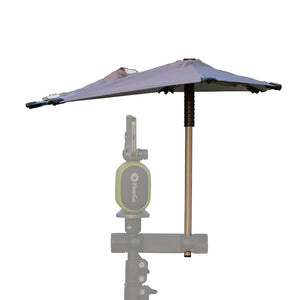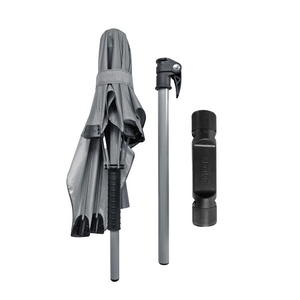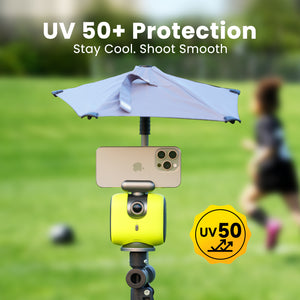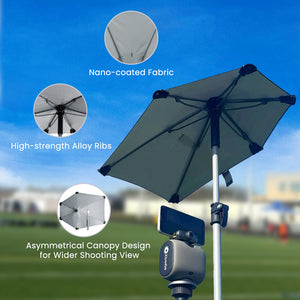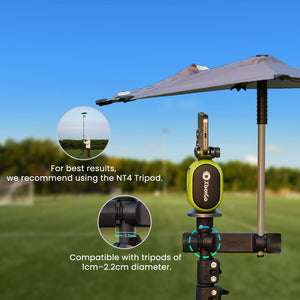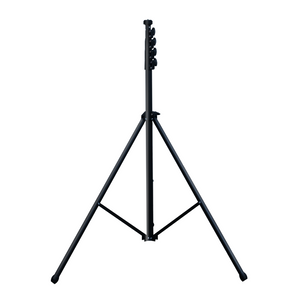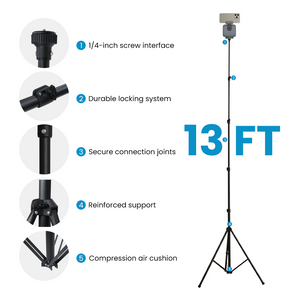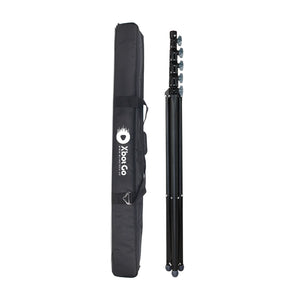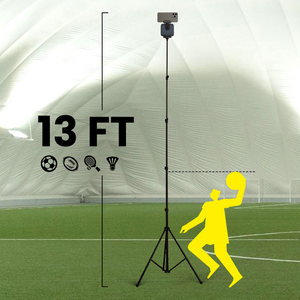XbotGo Chameleon AI Sports Camera
What is a Hockey Puck? The Complete Guide
Ever wondered what that black disc is that NHL players fire at 100+ miles per hour? You're not alone.
A hockey puck is a 6-ounce disc of vulcanized rubber that's exactly 3 inches wide and 1 inch thick. It's the heart of ice hockey—the object that turns frozen water into one of the world's fastest sports.
But here's what'll blow your mind: modern NHL pucks contain circuit boards, LED lights, and tracking technology that would make your smartphone jealous. They've come a long way from their origins as frozen cow dung (yes, really).
The Quick Facts Every Hockey Fan Should Know
Let's get straight to what matters:
Official NHL Puck Specifications:
- Weight: 5.5-6 ounces (156-170 grams)
- Size: 3 inches diameter, 1 inch thick
- Material: Vulcanized rubber
- Color: Black (for games), various colors for training
- Temperature: Kept frozen at -7 to -10°C during games
These specs haven't changed since Art Ross standardized them in 1940. What has changed? Everything else.
From Cow Dung to Circuit Boards: The Wild Evolution of Hockey Pucks
The Early Days Were... Interesting
Picture this: it's the 1800s, and hockey players are literally using frozen cow patties as pucks. When those weren't available? Wooden blocks. Sometimes square ones, because why not?
By the 1870s, players got creative. They'd slice lacrosse balls into thirds and use the middle piece. The Montreal Victoria Hockey Club finally said "enough is enough" in the 1880s and created the first round pucks.
The Tech Revolution Nobody Saw Coming
Remember the FoxTrax puck from the '90s? Fox Sports thought adding a blue glow and red streak to TV broadcasts would help new fans follow the game. Each puck cost $400-500 and lasted about 20 minutes.
Traditional fans hated it. One Canadian viewer described it as "like having a giant flashing neon sign during a game that made it unwatchable." The experiment died when Fox lost broadcasting rights in 1999.
But here's the twist: modern NHL pucks picked up where FoxTrax failed. Today's pucks contain:
- 12 LED lights blinking 60 times per second
- Infrared emitters for tracking
- Circuit boards and batteries
- 4-6 hours of battery life
The difference? You can't see any of it on TV. The technology is invisible to viewers but provides incredible data for teams and broadcasters.
What's Actually Inside a Hockey Puck?
Traditional Pucks: Simple but Sophisticated
I watched a YouTube video where someone cut open a regular puck. The result? Solid rubber throughout. But don't let that simplicity fool you.
The magic happens during vulcanization—a process that transforms soft rubber into the hard disc we know:
- Mix rubber with bonding materials and antioxidants
- Heat to 300°F for exactly 18 minutes
- Compress in specialized molds
- Add diamond cross-hatch texture around the edges for better stick control
Manufacturing expert insights from hockey communty reveal that actual production tolerances are much tighter than NHL rules require. While regulations allow 156-170 grams, most game pucks weigh exactly 166 grams. That's precision.
Modern Smart Pucks: Where Physics Meets Technology
Here's where it gets wild. Inside today's NHL pucks:
- The tech pod: A self-contained unit with LEDs and circuits
- Two-shell construction: The electronics sit in a cavity between rubber halves
- Multiple adhesive layers: Visible rings show the layered construction
- Individual numbering: Each puck is tracked throughout its life
How do they work? Officials activate them by smacking them hard (seriously). Then 30-60 cameras mounted in arena ceilings track the infrared signals, triangulating position and speed in real-time.
The Different Types of Hockey Pucks (And When to Use Them)
Training Pucks That Actually Make Sense
Not all pucks are created equal—and that's by design:
Youth Pucks (Blue, 4 oz):
Lighter weight helps kids develop proper technique without straining. If your 8-year-old is struggling with stick handling, this is your answer.
Weighted Training Pucks (Orange/Pink, 10 oz):
Want a harder shot? Practice with these. The extra weight builds strength in your wrists and forearms. Just don't use them in games unless you want some angry opponents.
White Practice Pucks:
Goalies love these because they're harder to see. It forces better focus and faster reactions. Think of it as hard mode for netminders.
Steel Pucks (2 pounds):
For wrist strength only. Never, ever shoot these. One person who worked in a hockey shop said they sold cases to auto shops—turns out they make perfect spacers for car lifts.
Street and Roller Hockey Options
Playing on concrete? You need different gear:
- Roller hockey pucks: Plastic with raised ribs to reduce surface friction
- Green Biscuit: The gold standard for off-ice training
- Foam pucks: For basement practice (your walls will thank you)
The Physics of Flying Rubber
Speed Records That'll Make Your Head Spin
The fastest recorded shot? 114.1 mph by Alexander Riazantsev in 2012. In the NHL, Zdeno Chára hit 108.8 mph.
But here's what those numbers really mean:
- Average NHL shot: 80-90 mph
- Beer league shot: 50-70 mph
- What it feels like to get hit: "Like someone swinging a hammer at you" (actual quote from a player on the community)
Why Pucks Are Frozen (And How They Know When to Change Them)
NHL teams freeze pucks to -7 to -10°C. Why? Frozen pucks:
- Don't bounce as much
- Slide more predictably
- Stay flat on the ice
Modern pucks have thermochromic paint that changes color when they warm up. When the logo turns purple, it's time for a fresh puck. Teams go through 40-45 pucks per game.
Real-World Uses Beyond Hockey
This might surprise you: hockey pucks have a second life outside the rink.
Auto shops love them:
- Jack pad protectors
- Suspension spacers
- Vibration dampeners
Some mentioned their local auto shop ordered 200 pucks at a time. Why? "They're a uniform height and don't compress," perfect for mechanical applications.
Other uses:
- Air compressor feet (reduces vibration)
- Furniture sliders
- Even defensive weapons (Oakland University distributed pucks to faculty as potential active shooter defense in 2018)
Shopping for Pucks: What Actually Matters
For Players and Teams
Stick with InGlasco brand pucks. Some people consistently rate them as the best, and they're the official NHL supplier.
Canadian vs. Slovakian manufactured? Users report no noticeable difference for recreational play.
Price range:
- Basic practice pucks: $2-3
- Team logo pucks: $8-10
- Game-used NHL pucks: $290-300
For Collectors
Want an authentic game-used puck? Look for:
- IR emitter bumps (6 on each side)
- Individual numbering
- Thermochromic paint
- Weight of exactly 166 grams
Best sources:
- NHL official website
- Team stores after games
- MeiGray (for authenticated game-used items)
Pro tip:
"Get a game-used from your favorite team. Unsigned game pucks are way more affordable than signed ones but just as cool to display."
Safety First: Respect the Puck
Let's be real: pucks are dangerous. A 6-ounce piece of vulcanized rubber traveling at 100 mph is essentially a weapon.
The tragic death of 13-year-old Brittanie Cecil in 2002 led to mandatory protective netting in all NHL arenas. It's a reminder that pucks demand respect.
At games:
- Always watch the play
- Don't lean over glass during warm-ups
- If a puck comes your way, protect your face first
For players:
- Wear proper protective gear
- Never shoot pucks at unprotected people
- Check your surroundings before shooting
The Bottom Line
The hockey puck has evolved from frozen cow dung to a precision-engineered marvel containing LED lights and tracking technology. Whether you're choosing training pucks, wondering why youth pucks are blue, or curious about those black discs flying across your TV screen, understanding the puck adds depth to appreciating hockey.
Next time you see a puck sailing into the top corner or sitting as a paperweight, you're looking at the heart of the fastest game on ice—166 grams of vulcanized rubber that represents decades of innovation and the evolution from hockey's humble beginnings to today's high-tech sport.
XbotGo Chameleon AI Sports Camera
Capture every moment with AI-powered tracking. Perfect for coaches, parents, and athletes who want seamless footage without manual filming.







 Soccer
Soccer Basketball
Basketball Ice Hockey
Ice Hockey Rugby
Rugby










